Cal
25: Simple, able and cheap
By
John Kretschmer
(originally published in Sailing magazine, February 1998)
With its
distinctive raised deck and long cockpit, the innovative Bill Lapworth
design evolved from the highly successful pocket ocean racer and
well known San Francisco Bay boat, the Cal 20. Built by Jensen Marine,
which at one time in the '60s was the largest production builder
in the country, and later by Bangor Punta Marine and others, the
Cal 25 had a long production run through all its incarnations. From
1965 through 1983, a couple thousand Cal 25’s were launched.
Don’t
confuse this original Cal 25 with a later Cal 25 that was beamier
and did not have a raised deck. It was in production for only a
short time.
The Cal 25 was originally marketed as an ocean racer that could
occasionally double as a cruiser during the golden age of fiberglass
boats when a 25-footer was considered big. The prospect of serious
cruising in a Cal 25 these days seems almost comical, however, it
can be done. In fact, Dave and Jaja Martin and their two young children
completely rebuilt a stock 25 and then proceeded to log 45,000 miles
while circumnavigating. That, however, is taking things to extremes.
The Cal 25 is actually a fine first for a family boat that delivers
pretty good performance while graciously tolerating learning miscues.
And most importantly, you can find an assortment of decent 25’s
on the market for around $5,000 (or less), while nice, late model
boats can be had for less than $10,000. A Cal 25 is a logical boat
to test the waters of family sailing before committing to a bigger
or newer boat and a big monthly payment.
First impressions
Aficionados of '60s designs quickly recognize the Cal 25 as a classic
collaboration of Bill Lapworth and Jack Jensen. From the spoon bow
to the flattish transom, from the wide cove strip to the raised
deck with long rectangular portlights, the Cal 25 cuts a handsome
profile. Lapworth usually saved his best work for what was below
the waterline and the 25 is no exception. Like a miniature Cal 40,
the 25 features a long fin keel and spade rudder, which was a radical
concept in 1965, and a relatively long waterline of 20 feet. The
displacement of 4,000 pounds was considered quite light, although
the cast lead ballast of 1,700 pounds certainly helps keep the 25
on its feet. In fact, the Cal 25 is a remarkably stiff boat, as
numerous ocean passages attest, and is by no means over-canvassed
with 286 square feet of sail area. By comparison, the Cal 25, yesterday’s
nimble racer, is heavier and has less sail area than a typical modern
pocket cruiser like the Catalina 250.
Construction
The Cal 25 hull is solid fiberglass and typical of the construction
methods of the day: it is rather thick, resin rich, and often not
all that fair with occasional hard spots and “print throughs”,
which means that the underlying glass fabric is visible in the surface
of the hull. The one-piece molded deck was reinforced with plywood.
The hull and deck joint, which is set on a small flange, is riveted
and covered with a 6-inch fiberglass tape from the inside. It is
covered with a rubber rubrail and therefore subject to damage from
impact. The lead keel is externally fastened and the spade rudder
is draped over a robust stainless steel stock. The forward bulkheads,
which are usually mahogany-faced plywood, and tabbed to the hull,
front a deck beam, which was actually molded into the deck and supports
the deck-stepped spar. The inboard chainplates are bolted through
the bulkheads as well.
What to look for
As with any older boat, especially one that has been raced hard
and put away wet, there are many problems to be aware of before
purchasing. With Cal 25’s,
however, it is difficult to comment on general problems because
the boats have usually been retrofit by previous owners along the
way and one can't always be sure what has and hasn't been upgraded.
Still, there are some common flaws to be on the lookout for. A lot
of old Cal 25’s
have soft decks, some are spongy. Invariably the plywood has rotted,
usually the result of a deck leak, and needs to be replaced. At
least the plywood is accessible in most places. Although it is a
big job, it is possible to stiffen wet deck sections with new marine-grade
plywood, although the purchase price should certainly reflect this
time-consuming repair project. If the deck is soft, it’s
likely that the main deck beam may be sagging or worse, delaminating.
Again, this is not a task for the mechanically challenged, yet it
is certainly a do-it-yourself-type task if you have adequate woodworking
and fiberglass skills. John Hall, who owns a 1970 Cal 25, Lady
Marion, suggests adding a new mast compression post at the same
time.
The forward bulkheads may also need attention. If the bulk heads
are pulling away from the hull, they can usually be wrangled back
into place, especially when the rig is out of the boat, and refiberglassed.If
they have begun to rot, usually caused by leaking chainplates, it
may be necessary to replace them. Unless you are literally stealing
the boat, you should probably look for another 25. Another common
problem is leaking portlights. Originally, they were safety glass
and if you need to replace them, use Plexiglas® or LEXAN®.
Also, the rubrail is often in sad repair and needs to be replaced.
Fortunately, Steve Seal of Seal’s
Spars and Rigging in Alameda, California, has new rub rails available.
When hauled, check the rudder for any signs of cracking. The original
rudder was light sandwich construction, subject to cracking, especially
after a cold winter on the hard. Seal, who was a rigger with Jensen
Marine in the '60’s,
is an excellent resource for Cal owners and can help you track down
a new rudder if necessary. Also, Cal 25’s
have a tendency to blister, although they are certainly not unique
in this category.
One item to inspect carefully is the electrical system. The original
boats came with an "optional" electrical system, that
was basic to say the least. Most boats come with some type of owner-installed
electrical system and these can vary wildly. Carefully check the
panel and wiring, being alert to twisted wire and taped-over connections.
These are not only a nuisance and cause electrical instruments to
fail, they can be dangerous. One final item to check carefully is
the main companionway hatch on older boats. The original design
was a three-piece model that not only slid on tracks, but popped
up. Many of these hatches were retrofitted at some point so be sure
to check the construction carefully.
On deck
The
cockpit is the most distinctive feature on the Cal 25. It is 7 feet
6 inches long, which represents 30 percent of the LOA, and is quite
comfortable. It can easily accommodate four adults. John Hall remembers
a time when he had 12 people on board on the Columbia River. In
a way it is surprising that the 25 has such a proud record of offshore
sailing because the voluminous cockpit and huge companionway are
certainly not designed for bluewater sailing. The 25 is a tiller
boat and, although I'm sure some have probably been retrofitted
with wheel steering, I have never seen or heard of one.
Although pulpits and lifelines were options, most boats on the market
have them. Be sure to carefully check that they are through-bolted
with backing plates, as owners often undertook this upgrade themselves.
|
 |
Specifications
LOA:
25'
LWL: 20'
Beam: 8'
Draft: 4'
Displacement: 4000 pounds
Ballast: 1700 pounds
Sail Area: 286sq. ft. |


|
|

